The universe spans 62 orders of magnitude from the smallest subatomic particles to the largest cosmic structures. Humans exist at the midpoint of this scale, uniquely positioned to observe both the microscopic and macroscopic realms.
Introduction
At some pointprobably while staring at the ceiling at 2 AM or zoning out in a caféyour brain may have tossed you an unsolicited question: "Okay, but like... how big is the universe?"
Not just "big," but Big-big. Capital B. Mind-melting big. Turns out, the answer is complicated, occasionally terrifying, and always weird. So let's do this. No PhD required. We'll start at the smallest known things in existence and zoom out to the edge of everything we know. Hold onto your oat milk latteit's gonna get spacey.
Hover over an object to explore its scale
Click and drag to interact with the cosmic scale.
Starting Tiny: What Even Is a Quark?
You've heard of atoms, right? Atoms are the tiny building blocks of matteryour socks, your coffee, the Moon, raccoons, ramen, the phone you're holding... all atoms.

A proton revealed at its core: two up quarks and one down quark bound by the strong nuclear force.
If an atom were a stadium, a quark's influence would be smaller than a gnat on a seat cushion... on another planet.
Wilder still: most of an atom is empty space. Squeeze out that emptiness from every atom in your body, and you'd shrink to the size of a grain of ricestill weighing as much as you do now, but way denser and harder to shop for jeans.
Atomic Nucleus
Size of a proton or neutron
DNA Helix
Width of DNA molecule
Human Cell
Typical size of a human cell
The Human Scale: Smack-Dab in the Middle
Zoom out to something relatable: you. A walking tangle of star-born molecules, about 1.7 meters tall (give or take height and hair), made of roughly 37 trillion cells. Each cell holds DNAa molecular blueprint that, if unraveled from every cell in your body, could stretch to Pluto and back over 12,000 times.
Humans are basically cosmic spaghettistretched thin, drifting aimlessly, yet still craving snacks.
Here's the kicker: the carbon, oxygen, iron, and calcium in you were forged in the hearts of dying stars. Supernovaestellar explosionsflung those elements into the cosmos, which later coalesced into planets, plants, penguins, and podcasts.

Supernova Remnant W49B
Credit: X-ray: NASA/CXC/MIT/L.Lopez et al; Infrared: Palomar; Radio: NSF/NRAO/VLA
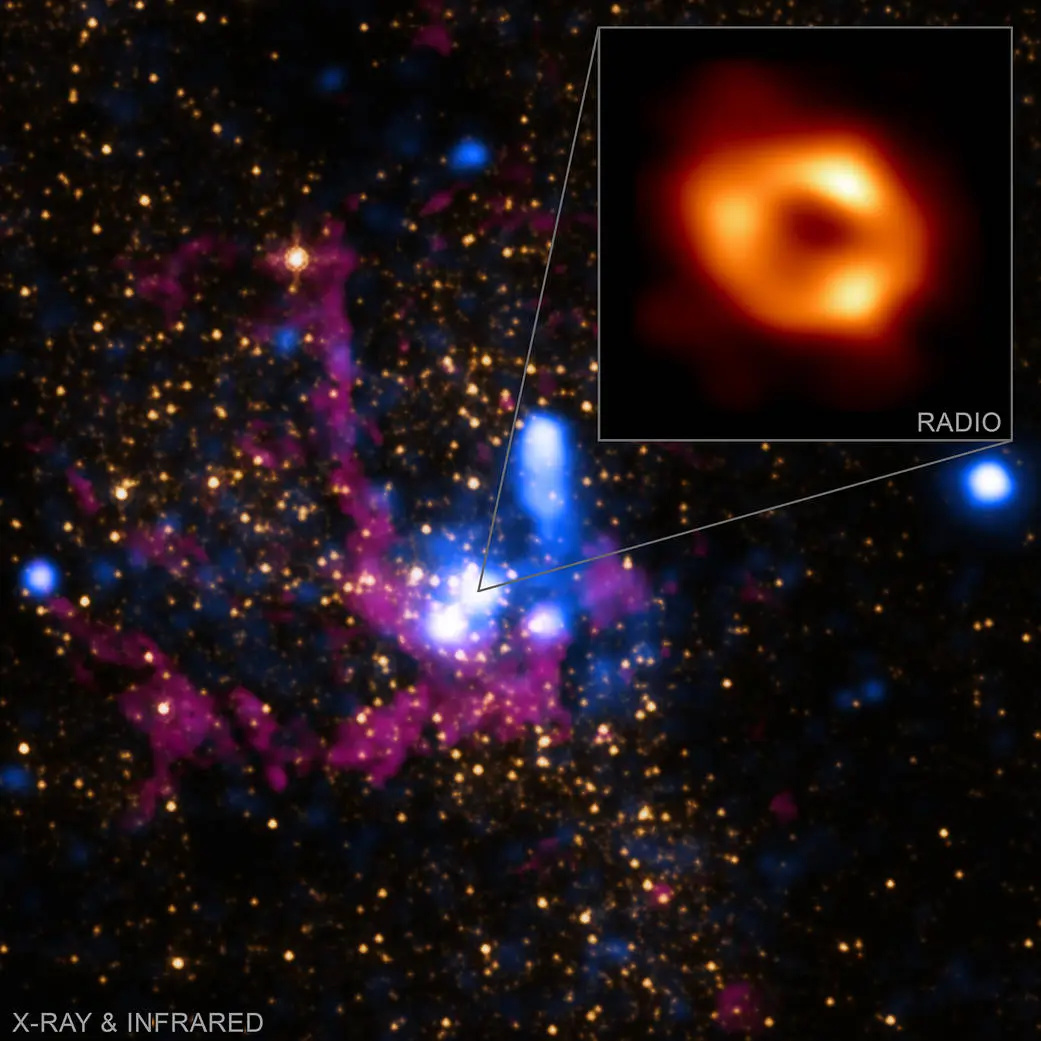
Multiple telescopes, including Chandra, observed the Milky Way's giant black hole simultaneously with the Event Horizon Telescope (EHT).
Credit: X-ray: NASA/CXC/SAO; IR: NASA/HST/STScI. Inset: Radio (EHT Collaboration)
You're tiny on a universal scale, but a direct result of itstardust with Wi-Fi and thumbs, observing the universe while munching snacks.
"We are a way for the cosmos to know itself. The cosmos is within us. We are made of star-stuff."
Earth: Big? Yes. But Also... No.
Earth feels massive when you're trudging uphill. It's roughly 12,742 kilometers in diameter, home to oceans, mountains, Wi-Fi, and too many pigeons.
But then there's the Suna nuclear furnace 109 times wider than Earth, able to fit 1.3 million Earths inside if it weren't busy incinerating anything nearby. It shines via nuclear fusion, smashing hydrogen atoms into helium and releasing energy that powers your plants, pets, and playlists for 4.6 billion years.
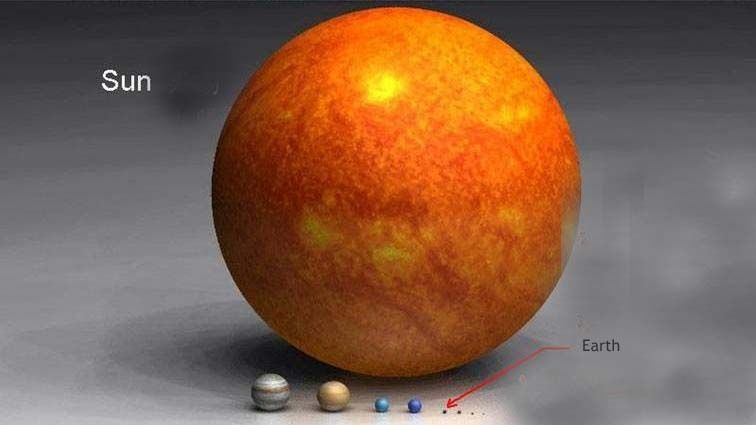
The Speed of Light & The Light-Year: Distances Get Weird
Light zips along at 300,000 kilometers per second, circling Earth 7.5 times in a blink. Space is so vast we measure distances in light-yearsthe distance light travels in a year.
Let's break it down:
- The Moon? 1.3 light-seconds away.
- The Sun? 8 light-minutes.
- Pluto? ~5.5 light-hours.
- Proxima Centauri? 4.24 light-years, or 25 trillion reasons we're not visiting soon.
.jpeg)
The Hubble Space Telescope captures Proxima Centauri, our nearest stellar neighbor, glowing just over four light-years away in the southern constellation Centaurus.
Credit: NASA and ESA.
The Milky Way Galaxy? 100,000 light-years across.
The observable universe? ~93 billion light-years wide, thanks to cosmic expansion stretching space itself. "Observable universe" means we can't see beyond that. More galaxies? Cosmic void? Space raccoons? Who knows?
Just remember: a light-year measures distance, not timedespite sounding like a sci-fi sequel.
Welcome to the Milky WayWatch Your Step, There's a Black Hole in the Center
The Milky Way is your cosmic addressa gorgeous spiral of 100 to 400 billion stars, stretching 100,000 light-years across, like a pancake made of fire, gravity, and glitter.
We live in its quiet Orion Arm suburb, far from the galactic core, where a supermassive black hole, Sagittarius A*, lurks.
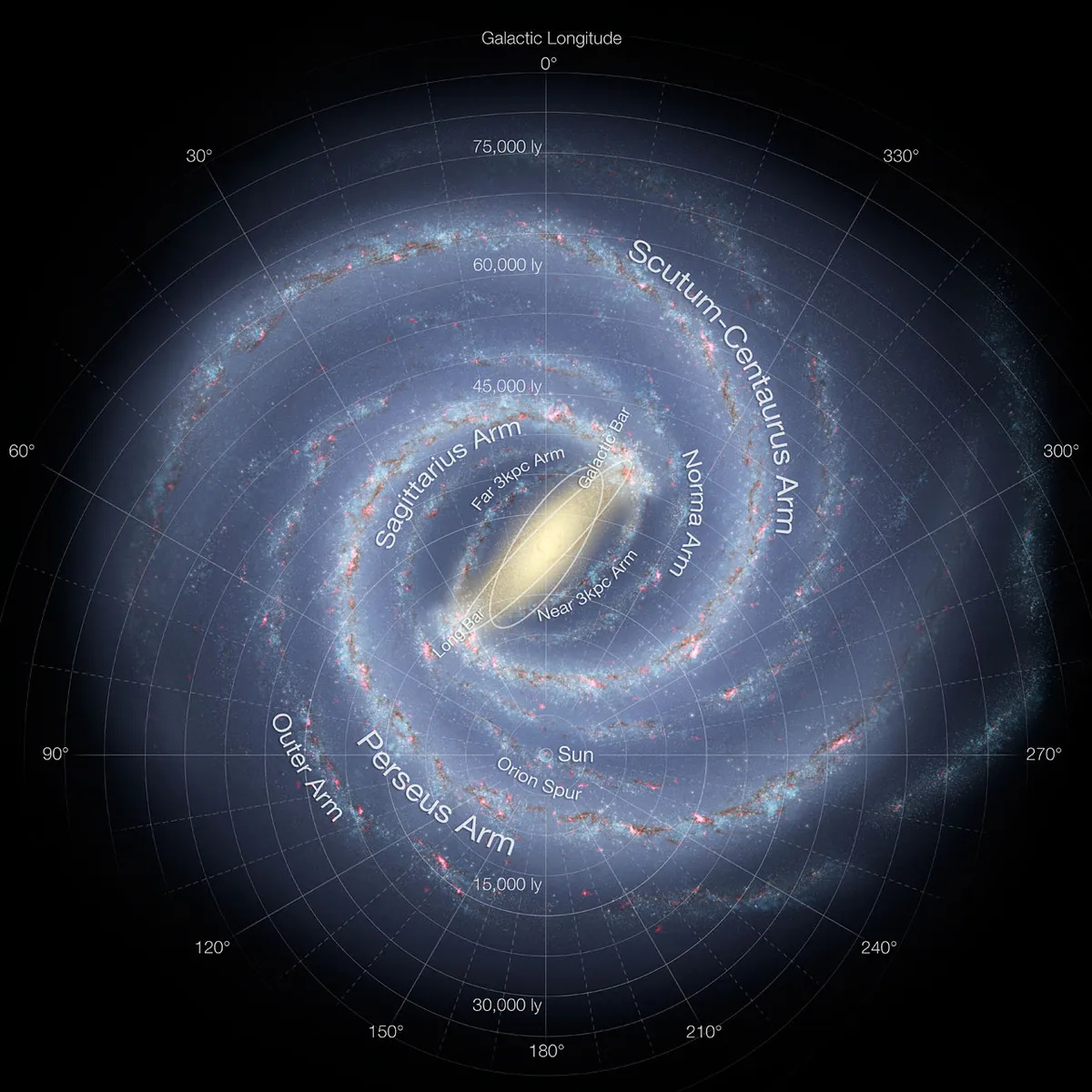
An impression of the Milky Way as seen from the outside.
Credit: NASA/JPL-Caltech/ESO/R. Hurt.
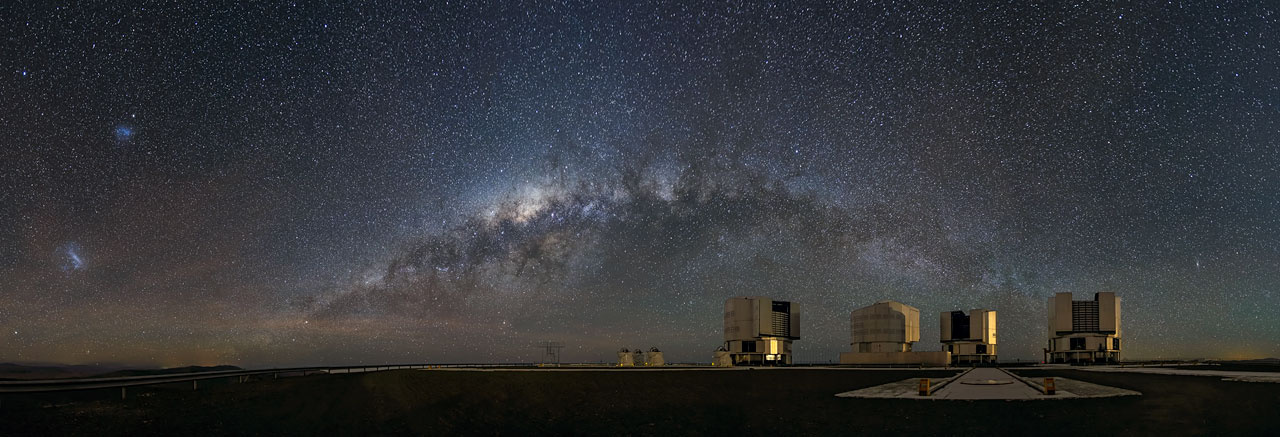
This panorama captures the majestic arc of the Milky Way galaxy stretching across the night sky above the platform of ESO’s Very Large Telescope (VLT), perched atop Cerro Paranal in Chile’s Atacama Desert. .
Credit: John Colosimo (colosimophotography.com)/ESO.
Shrink the solar system to a coin. Now scatter 100 billion coins across a continentthat's our galaxy. You? A dust mote riding one. And the Milky Way is just one of trillions of galaxies.
Galaxy Facts
- 100-400 billion stars in the Milky Way
- 100,000 light-years across
- 13.6 billion years old
- Supermassive black hole at center: 4 million suns
Quasars: Black Holes Having Their Drama Queen Era
Now it gets flashy. Some galaxies host supermassive black holesmillions or billions of times the Sun's mass. Quasars form when these black holes feast on matter, releasing energy that outshines entire galaxies.
Picture a cosmic rave: matter spirals around a black hole at nearly light speed, forming an accretion disk of gas and dust. Particles in this disk smash and grind, heating to millions of degrees and blazing brighter than the galaxy itself.
One quasar can outshine thousands of stars. We've spotted them 13 billion light-years away, from when the universe was a baby. Baby universe, mega rage lightsadorably intense.
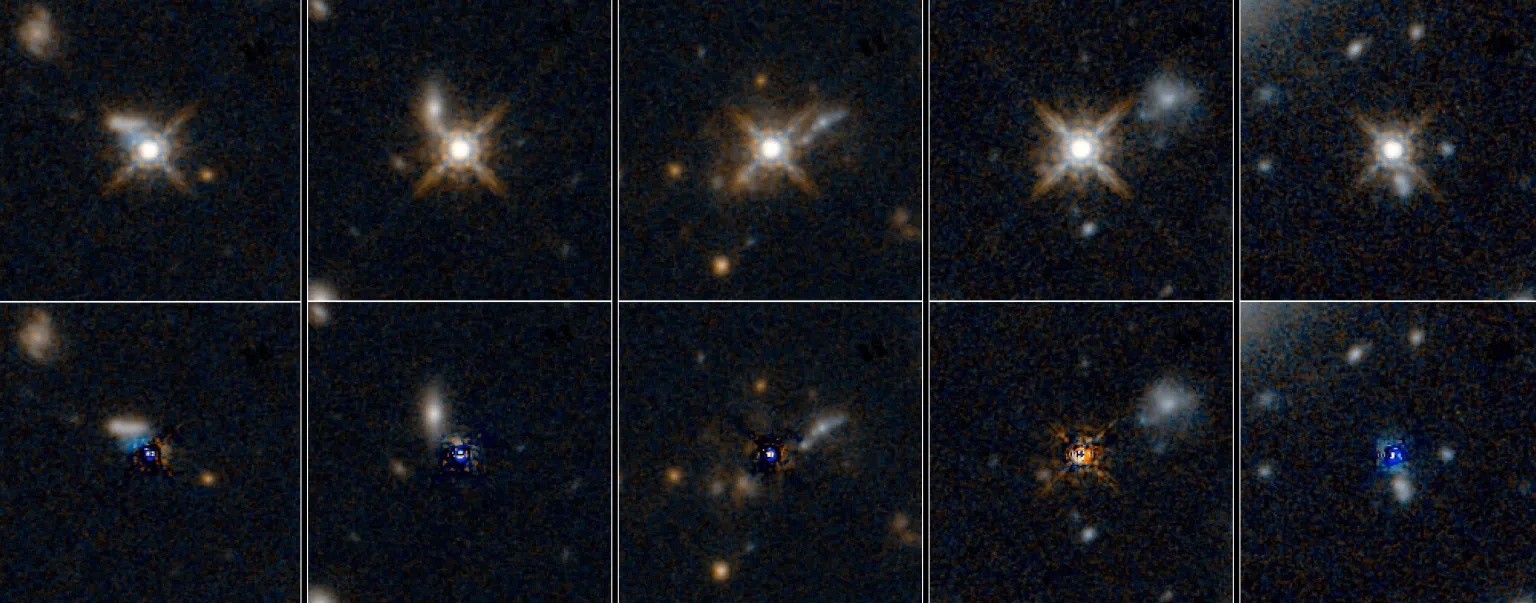
Top row: Hubble images of 11 dusty, ultra-bright quasars from 12 billion years ago.
Bottom row: Glare removed, exposing hidden galaxy collisions fueling their supermassive black holes.
Credit: NASA, ESA, and E. Glikman (Middlebury College, Vermont)
To see a world in a grain of sky (Reflections on the Hubble Deep Field)
In 1995, astronomers pointed the Hubble Space Telescope at what seemed like an empty patch of sky. Over 10 days, it collected light from some of the most distant objects ever observed. The result? The Hubble Deep Field a photo filled with over 3,000 galaxies, some over 12 billion years old.

A central slice of the 1995 Hubble Deep Field covering only 1/13th the width of the full Moon yet filled with ancient galaxies stretching across cosmic time..
Credit: NASA, Robert Williams, and the Hubble Deep Field Team (STScI)
That tiny speck of sky no bigger than a grain of sand at arm’s length revealed a universe bursting with galaxies. It’s a humbling reminder that **most of the universe is hidden in plain sight**, waiting to be seen.
So... What Does It All Mean?
You're a speck on a damp rock circling a midlife star in a cosmic suburb, one of trillions of galaxies. Statistically, you're insignificant.
Yet you think. You wonder. You look up and try to grasp it all. From quarks to quasars, it's all connecteda vast story with you smack-dab in the middle. The universe sprouted neurons, discovered snacks, and began questioning itself.
So, how big is big? Big enough to dwarf you, small enough to fit in your imagination, strange enough to keep us guessing forever. You're stardust with a spark of the cosmos, finding your wayone moment, one snack, at a time.